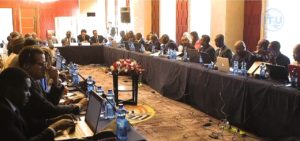PRIDA Track 1 is the ITU implemented part of PRIDA, which aims to promote harmonized spectrum utilization and regulations across Africa.
In some areas such as Africa, further efforts must be mobilized to leverage the promise of ICTs and allow for greater efficiency of national economies. Countries in Africa are faced with the challenge of forging appropriate policies and strategies to make ICTs available, affordable and accessible as a vital development enabler for building inclusive, resilient and sustainable modern-day knowledge societies.
ICT infrastructure in Africa has evolved significantly during recent decades, including new international undersea cables circling the continent. As for the other continents, the demand for broadband connectivity – and by extension, the demand for spectrum and rolling out of high-speed broadband networks for electronic communications-, is a growing fact of life. However, availability and affordability of broadband access are still challenges in many African countries. The low level of broadband penetration remains as an inhibitor for deployment of internet based services which have the potential to unlock social and economic development and foster efficient public services.
In this context, all African countries must take measures to address the important issues of radio frequency spectrum, its timely assignment, harmonization of its use and its availability to promote the adoption and deployment of mobile broadband. The unrelenting pace of change in the development of ICTs calls for diversity and adaptability of policy, legal and regulatory practice. Allowing ICT markets to thrive today is a matter of finding the balance between creating the right incentive and enforcing the necessary rules.
The importance of shaping fair, transparent, stable, predictable and non-discriminatory legal and regulatory environment that promotes competition and attracts investments cannot be overstated. While in the recent years, many African countries have progressed towards greater competition, more work needs to be done to foster the roll-out of broadband networks and make it affordable and accessible.
Sound policy and regulatory frameworks for broadband at national level and harmonization at regional and Pan-African levels play a crucial role in view of laying the foundation across the continent for a truly integrated market for ICT services enabling investments, innovation and growth in the ICT sectors and across economies.
Despite the initiatives carried out by various stakeholders, a lot still needs to be done to consolidate and to advance them. In order to gain full benefit of potential broadband networks, it is essential to ensure the deployment of optical fibre, for example, for connecting base stations. To this end, it is necessary to have the current situation of optical fibre deployment to orient investments in areas with optical fibre infrastructure deficit.
Regarding effective radio spectrum management, a stable and predictable framework shall ensure that radio spectrum is made available based on administrative procedures that are (i) open, (ii) transparent and (iii) non-discriminatory.
Therefore, Track 1 aims to focus on the creation of an enabling environment, in particular concerning radio spectrum framework to orient operators towards the best solutions for the system’s long-term cost-effectiveness, quality, and sustainability and to prepare an environment supportive of internet based services.
Harmonization efforts at Pan-African level of the four (4) core functions (spectrum licensing, spectrum pricing, spectrum refarming and cross border frequency coordination) will create the conditions for economies of scale and thus a rapid deployment of wireless broadband, filling an important gap in complementing the ongoing infrastructure-focused efforts towards increased ICT use across the continent.
Track 1 includes 27 actions ranging from the creation of continental and regional guidelines, to capacity building, and including helping countries to transpose guidelines at national level, direct technical assistance, conferences, implementing HCM4A, etc.

Developing Guidelines on radio frequency regulation based on ITU Radio Regulations, ITU-R Recommendations, Reports and Handbooks, regional harmonization frameworks, case studies, country experiences and regional consultations.
Developing Guidelines for national radio frequency spectrum coordination including refarming methods.
Based on the Guidelines above propose improvements of national radio spectrum regulations.
Based on the Guidelines above propose harmonized refarming plans for the usage of frequency bands identified for wireless broadband.
Based on the Guidelines above propose roadmap and priorities for wireless broadband deployment in Africa.
Providing technical assistance for national spectrum entities to transpose these roadmaps.
Collect information on the availability of the backhaul links (incl. fiber).
Assessing the HCM4A agreement for sub-Saharan Africa and make assessment on current cross border frequency coordination agreements + Updating the number of countries interested in implementation of the HCM4A + Updating HCM4A agreement taking into account the results of the assessments and the updated version of the HCM Europe
Updating cross-border frequency coordination agreements for wireless broadband deployment
Organizing workshops to validate the updated cross border frequency coordination agreement and developing the HCM4A software
Providing support to the implementation of the updated HCM4A agreement and the software in Africa
Developing guidelines and associated case studies regarding type approval regulations
Developing guidelines and associated case studies regarding EMF and EMC for IoT
Preparing Guidelines for radio frequency spectrum licensing for wireless broadband + Preparing Guidelines for pricing + Preparing Guidelines for usage + Preparing Guidelines for HCM4A
On request assisting countries in specific cases for cross border frequency coordination and providing technical assistance for the resolution of critical situation
Providing policy outreach on concept and business models of IoT.
Providing overview on the ITU activities and ensuring participation in relevant ITU meetings.
Organizing workshops on digital technologies and relevant frequency issues in relation to IoT.
Organizing capacity building workshops.
Organizing two 5G annual African Continental Conferences.
Provide direct technical assistance to countries (on demand), on: a) The transposal of our Guidelines for pricing; b) Digital Migration; c) Implementation of modern spectrum management regulatory framework; d) Updating national allocation tables; e) Others (as requested by countries)